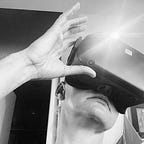The Value of Virtual Reality as a Behavior Changing Medium
This is a high level overview of this topic — if you want a deeper dive, I highly suggest reading Jeremy Bailenson’s fantastic book, Experience on Demand.
If I knew more about football, I’d probably describe this better, but bear with me. It’s the fourth quarter, and the QB is about the throw the deciding play. He should feel overwhelmed, but instead he feels a sense of peace and familiarity — he’s seen this situation a hundred times before. He tosses perfectly and a touchdown is scored. But here’s the trick of the thing — it was a play he’d never completed in real life until that moment. Rather, he had rehearsed it over and over in a VR headset, seeing the play again and again until it felt like second nature.
Sure, you might be thinking, this is all well and good for the best athletes in the game, when the Superbowl is on the line. But many of us face stressful situations in our daily lives, and VR can help change our responses to these scenarios by creating a sense that we’ve been there before, and it’s really not so scary. The oft-referenced “cone of learning” ranks the best way to retain knowledge, with real-life experience topping the chart — but real life experience is often too dangerous or difficult to fully replicate.
For anyone who has ever worked in a service industry, there’s the dreaded moment of dealing with your first irate customer. Sure, you can watch videos or role play with your co-worker, but come on…you all know Janet from HR is the nice lady who brings cookies on Fridays and not the mean client who wants you to do the impossible. Likewise, sure, the best way to learn to drive a forklift is to actually drive one — but that’s also a huge risk for anyone in the warehouse who happens to be in the way of a first timer.
Interactive VR is great for these experiences, but even being a passive observer in 3dof headset can go a long way. Just watching a stressful situation happen around you and feeling close to it can reduce anxiety and create a muscle memory, so when you do face that situation, you have a baseline familiarity and can then work out next steps to dealing with it. Too often we put people in high-stress situations without the proper training, and that can have deadly consequences. Sure, getting yelled at by a customer for making a latte wrong probably won’t do much more than ruin your day, but if you’re a law enforcement officer dealing with a mentally ill person and it’s your first time in that situation, things can go very wrong very quickly.
VR can also be great for training people to deal with unfamiliar situations in a culturally sensitive manner, and getting them to see different types of people as fellow humans. Too often people are afraid of others because they’ve simply never encountered people like them — and allowing them to spend time in VR getting comfortable would go a long way.
I’m always loathe to dive into whether VR is an empathy machine, in the words of Chris Milk, because it can just as easily be twisted and used to create and reinforce biases. But there is a growing body of research that suggests it can lead to fundamental shifts in the way we behave.
